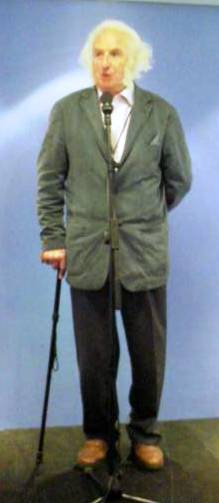
Dawne Riddle attends a book launch at the Bicentennial Conference.
Geoscientist Online 11 September 2007
No gathering of geoscientists is likely to shut up and listen to someone else willingly, even if he is the President. Happily, Gordon Herries-Davies (Trinity College Dublin), author of the Society’s Bicentenary history Whatever is Under the Earth, is gifted at commanding even the toughest of tough rooms. And they don’t come much tougher than a wine reception at the end of the first day of an international geoscience conference.
The distinguished historian of Earth sciences cut a strange figure among the delegates, as he stepped up to the microphone following Richard Fortey’s introduction – like a cross between William Buckland and Great Uncle Bulgaria. Yet his resounding voice, refreshingly fruitier than has become the norm these days, swiftly silenced the hubbub, as he explained how he had received the commission to write the Society’s story, over 10 years ago.
His famous history of the Irish Geological Survey, North from the Hook: 150 Years of the Geological Survey of Ireland (1995) played a key role, he told the audience. By the late 1980s, the Society already had one eye cocked on its looming 200th birthday. The Publications Committee some years later conceived the idea of commissioning a historical work that would cover the whole of the Society’s history since its foundation, in a readable and accessible way – one that would prove more interesting to the general geologist reader than some dry, academic tome.
Professor Wally Pitcher, a former President of the Society, had first suggested to Council that a bicentenary history be written, and as is the way with such things, Council handed the task to him. Pitcher then undertook research towards such a history; but after ten years of interviewing geological notables, Pitcher may have felt that finishing the task was now beyond him. Herries Davies was then approached in an exploratory phonecall by the then President, Richard Hardman, to the author's home in Tipperary. Never one to beat around the bush, Hardman's first question was: "How's your health been lately?".
“A copy of my Irish history had swum into the ken of the Publications Committee” Herries-Davies intoned. “And hence there came a summons to Burlington House - and a meeting of which I now forget the details; though I came away with the message that they wanted me “to do one of these for us”.”
Also, perhaps with another eye towards history, they were perhaps anxious not to repeat the publishing disaster of Horace Bolingkbroke Woodward’s Centenary history. This rather arid catalogue of events and personalities, though a useful reference today, was for years a drain upon the Society’s resources as the massively over-numerous edition languished unsold in the basements of Burlington House, eventually to be rather unceremoniously remaindered. After sending a free copy to everyone who had attended the centenary celebrations as a guest or delegate – the Society had got a little carried away and ordered a further run of 500. These copies were still hanging around in 1943, at which time Council decided to give one away to every new Fellow elected, and to any library that asked for one, until the stock was cleared.
The other message Herries-Davies carried away from his meeting was that the Society never paid royalties – a fact which, he said “absolves me of any accusation that this is some kind of self-interested sales-drive on my part! No, I merely want the book to be read and if my presence here today can in any way assist in that process of dissemmination, I shall feel that I have been amply recompensed.”
He told the reception: “I vowed before beginning this work that I should approach it in a rather different way and not recoil from putting a little of myself into it.” That has proved the key secret of this engaging, and characteristically orotund book. I heard a nearby delegate whisper to another: “It’s true – you can hear him speaking in every word”.
Thus, as one correspondent has written in a letter to Geoscientist: “ Rarely have I come across a book that is so readable, enjoyable and informative …. Author and publisher are to be congratulated on producing an incredibly detailed record of the Society's history in such a high quality book.”
Signings by the author continue today (11 September) at 12.45pm.